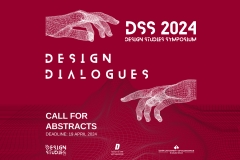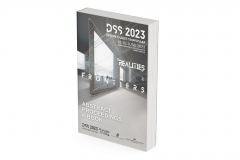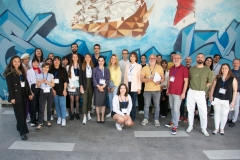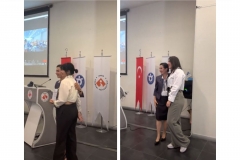
GRADUATE SCHOOL
Design Studies (With Thesis)
FFD 572 | Course Introduction and Application Information
| Course Name |
Creativity and Design Management
|
|
Code
|
Semester
|
Theory
(hour/week) |
Application/Lab
(hour/week) |
Local Credits
|
ECTS
|
|
FFD 572
|
Fall/Spring
|
3
|
0
|
3
|
7.5
|
| Prerequisites |
None
|
|||||
| Course Language |
English
|
|||||
| Course Type |
Elective
|
|||||
| Course Level |
-
|
|||||
| Mode of Delivery | - | |||||
| Teaching Methods and Techniques of the Course | - | |||||
| Course Coordinator | ||||||
| Course Lecturer(s) | - | |||||
| Assistant(s) | - | |||||
| Course Objectives | 1) To observe the nature of creativity with respect to design and the designing process.2) To form a common platform where management and design issues meet and communicate 3) To encourage creativity in organizations and people’s lives by innovative design methods |
| Learning Outcomes |
The students who succeeded in this course;
|
| Course Description | This course explores the relationship between design, creativity and design management. |
|
|
Core Courses | |
| Major Area Courses | ||
| Supportive Courses |
X
|
|
| Media and Management Skills Courses | ||
| Transferable Skill Courses |
WEEKLY SUBJECTS AND RELATED PREPARATION STUDIES
| Week | Subjects | Related Preparation |
| 1 | Orientation; General Overview of the course. Nature of human creativity | |
| 2 | Creative Process: RecognitionPreparationIncubationIlluminationVerification | Reading:Basalla, George (1988), The Evolution of Technology, Cambridge University Press (trans. by Cem Soydemir as “Teknolojinin Evrimi”, Ankara Tübitak Popüler Bilim Kitapları, 1996) |
| 3 | Nature of ceativity and design with respect to art, science and management. Bibliography and resources | Weekly Project: Creative Persona |
| 4 | Management Structures of Products and Services in Conventional Industries (Advantages – Disadvantages) | Weekly Project: Creative Persona |
| 5 | OEM Original Equipment Manufacture – ODM Original Design Manufacture OBM Original Brand Management – OSM Original Strategy Management | Reading: Heskett, John \"The Economic Role of Industrial Design\" The Role of Product Design in PostIndustrial Society (ed. Tevfik Balcıoğlu) , Ankara METU Faculty of Architecture Press, pp 77 92 |
| 6 | Innovation, Design & Management | |
| 7 | Design Management of Innovative Processes | |
| 8 | Organization and leadership in design management | |
| 9 | Midterm | Midterm Preparation |
| 10 | Case Industrial Design Studies: Design and development of an industrial product | Reading: Olson, Er,c M. (et al). “Managing Design for Competitive Advantage: A Process Approach” Design Management Journal, Vol 11, No. 4, Fall 2000, Design Management Institute, pp. 10 17 |
| 11 | Case Industrial Design Studies: Design and development of an industrial product | Reading: Perkins, Shel (2006). Talent Is Not Enough. Business Secrets for Designers, Peachpit Press |
| 12 | Design Management as entrepreneurship | Reading: Perkins, Shel (2006). Talent Is Not Enough. Business Secrets for Designers, Peachpit Press |
| 13 | Case study for design management as entrepreneurship | |
| 14 | Research Submissions | |
| 15 | Overall Evaluation | |
| 16 | Review of the Semester |
| Course Notes/Textbooks | Basalla, George (1988), The Evolution of Technology, Cambridge University Press (trans. by Cem Soydemir as “Teknolojinin Evrimi”, Ankara Tübitak Popüler Bilim Kitapları, 1996) Borja de Mozota, Brigitte (2004). Design Management: Using Design to Build Brand Value and Cooperate Innovation. Allworth Press Boyle, Griff (2003), Design Project Management, Ashgate Davila, Tony (with Marc J. Epstein, Robert Shelton – 2006), Making Innovation Work: How to Manage It, Measure It, and Profit from It, Wharton School Publishing Design Discourse, Journal of Design History and Design Philosophy Design Management Journal, Design Management Institute, Boston Forty, Adrian (1986 ), Objects of Desire, London Thames and Hudson Fuller, R. Buckminster (1981), Critical Path, NY St. Martin’s Press Heskett, John (1980). Industrial Design, London, Thames and Hudson Kelley, Tom (2001). The Art of Innovation, Doubleday Neumeier, Marty (2006). ZAG: The Number One Strategy of High Performance Brands, Peachpit Press Perkins, Shel (2006). Talent Is Not Enough. Business Secrets for Designers, Peachpit Press Articles Benjamin Walter, \"Art in the Age of Mechanical Reproduction\", 1935 Henry, Jane. The Nature and Development of Creativity\", codesign (ed. David Walker, Barry Dagger), 101112, 1994 Heskett, John \"The Economic Role of Industrial Design\" The Role of Product Design in PostIndustrial Society (ed. Tevfik Balcıoğlu) , Ankara METU Faculty of Architecture Press, pp 77 92 Olson, Er,c M. (et al). “Managing Design for Competitive Advantage: A Process Approach” Design Management Journal, Vol 11, No. 4, Fall 2000, Design Management Institute, pp. 10 17 |
| Suggested Readings/Materials |
EVALUATION SYSTEM
| Semester Activities | Number | Weigthing |
| Participation | ||
| Laboratory / Application | ||
| Field Work | ||
| Quizzes / Studio Critiques | ||
| Portfolio | ||
| Homework / Assignments |
2
|
10
|
| Presentation / Jury |
2
|
20
|
| Project |
2
|
20
|
| Seminar / Workshop | ||
| Oral Exams | ||
| Midterm |
1
|
20
|
| Final Exam |
1
|
30
|
| Total |
| Weighting of Semester Activities on the Final Grade |
70
|
|
| Weighting of End-of-Semester Activities on the Final Grade |
30
|
|
| Total |
ECTS / WORKLOAD TABLE
| Semester Activities | Number | Duration (Hours) | Workload |
|---|---|---|---|
| Theoretical Course Hours (Including exam week: 16 x total hours) |
16
|
3
|
48
|
| Laboratory / Application Hours (Including exam week: '.16.' x total hours) |
16
|
0
|
|
| Study Hours Out of Class |
15
|
6
|
90
|
| Field Work |
0
|
||
| Quizzes / Studio Critiques |
0
|
||
| Portfolio |
0
|
||
| Homework / Assignments |
2
|
5
|
10
|
| Presentation / Jury |
2
|
10
|
20
|
| Project |
2
|
20
|
40
|
| Seminar / Workshop |
0
|
||
| Oral Exam |
0
|
||
| Midterms |
1
|
3
|
3
|
| Final Exam |
1
|
4
|
4
|
| Total |
215
|
COURSE LEARNING OUTCOMES AND PROGRAM QUALIFICATIONS RELATIONSHIP
|
#
|
Program Competencies/Outcomes |
* Contribution Level
|
||||
|
1
|
2
|
3
|
4
|
5
|
||
| 1 | to be able to expand the practical knowledge gained in undergraduate programs with theoretical field of design research, |
X | ||||
| 2 | to be able to examine, interpret data and assess concepts and ideas with research methods of design theory and social sciences, |
X | ||||
| 3 | to be able to identify problems of design disciplines in times of global / environmental crisis and to be able to develop possible solutions for design practitioners, |
X | ||||
| 4 | to be able to expand knowledge on the history of material culture as it relates to design practices of the past, |
X | ||||
| 5 | to be able to promote research on local practices of everyday life and assess the outcome to implement design solutions, |
X | ||||
| 6 | to be able to facilitate interactions in between varied design disciplines and to promote collaborative work to solve complex problems, |
X | ||||
| 7 | to be able to process outcome of design research to be applied in design education, |
X | ||||
| 8 | to be able to instigate research on the new tools, technologies and materials of production in order to accelerate changes in design practices, |
X | ||||
| 9 | to be able to develop an ethical approach towards design professions in order to install social and environmental responsibilities, |
X | ||||
| 10 | to be able to use a foreign language for both chasing the scientific publication and developing proper communication with colleagues from other countries, in written and verbal ways. |
X | ||||
| 11 | to be able to use computer programs needed in the field design as well as information and communication technologies in advanced levels (“European Computer Driving Licence”, Advanced Level”). |
X | ||||
*1 Lowest, 2 Low, 3 Average, 4 High, 5 Highest
NEWS |ALL NEWS

DSS 2024 CALL FOR PAPERS | THEME: DESIGN DIALOGUES
DSS 2024 CALL FOR PAPERS THEME: DESIGN DIALOGUES The Design Studies Graduate Program and the Faculty of Fine Arts and Design at the Izmir

Abstract Proceedings e-Book for the Design Studies Symposium 2023 is available now!
The Design Studies Symposium 2023 (DSS 2023), organized in collaboration with İzmir University of Economics Graduate School Design Studies Master's and PhD

Design Studies Symposium 2023: Realities & Frontiers
The Design Studies Symposium 2023 (DSS 2023) organized by the IEU Graduate School Design Studies programs was held on 1-2 June, at

The Best Paper Award at the Design Studies Symposium 2023: Realities & Frontiers
The voting for the best presentation award at the Design Studies Symposium 2023 (DSS 2023) organized by the IEU Graduate School Design




